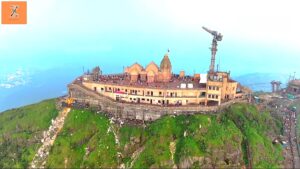7 Stunning Historical facts about Pavagadh Shaktipeeth: Complete Guide

Among the 51 Shaktipeeths dedicated to Goddess Sati, Pavagadh Shaktipeeth holds immense significance. Located in the Panchmahal district of Gujarat, this sacred shrine of Maa Mahakali sits at an elevation of 800 meters above sea level. One of the unique aspects of this temple is the idol of Maa Mahakali, which faces south—a rare and distinctive feature among temples. It is considered one of the most vibrant and powerful Shaktipeeths because it is believed that the right toe of Goddess Sati fell at this location.
Every year, millions of devotees visit this temple to seek blessings and experience its divine aura. Visitors can also enjoy the famous ropeway ride to the temple, which adds an adventurous element to their spiritual journey.
If you are planning to visit Pavagadh Shaktipeeth, this guide will provide all the essential information, including travel tips, costs, and the best way to make the most of your trip. Let’s begin!
How to Reach Pavagadh Shaktipeeth
Reaching Pavagadh is relatively easy, as it is well-connected by rail and road.
- By Train:
The nearest railway station to Pavagadh is Vadodara, situated approximately 55 kilometers away. Once you arrive at Vadodara Railway Station, you can walk to the nearby bus depot, which is just a 5-minute walk. Buses to Pavagadh are available from Gate No. 15–16 at the depot. The ticket price is approximately ₹45, and the journey takes about 2 to 3 hours. - By Road:
For those traveling by personal vehicle, there are parking facilities available at Pavagadh Hill. Two-wheelers are charged ₹20, while four-wheelers cost ₹200. From the bus depot, you can also hire a shared taxi (₹100 per person) or board a local bus (₹20 per ticket) to reach the hill base.
Accommodation Options
Several hotels near Pavagadh cater to varying budgets, with prices ranging from ₹500 to ₹3500 per night. For a same-day visit, you can also stay in Vadodara and return after completing the darshan.
The Journey to Pavagadh Temple
Once you reach Pavagadh Hill, there are two ways to reach the temple:
- Climbing the Stairs:
For the adventurous, you can climb 2000 steps to the temple. This route is surrounded by scenic views and gives a sense of spiritual accomplishment. - Ropeway Ride:
For a more comfortable experience, opt for the ropeway, popularly known as Udankhatola. This ropeway ride is one of the highest in India and offers breathtaking views of the surrounding landscapes. The ropeway tickets cost ₹150 for adults and ₹80 for children (round trip). It is advisable to book tickets in advance through Udankhatola.com to avoid long queues, especially on weekends.
Attractions Along the Way
While heading to the temple, you will come across a bustling marketplace where you can buy prasad and puja essentials. A short walk from here leads to the serene Dudhiya Talab (Milky Pond), which is steeped in local legends and adds to the spiritual experience. From this point, a large entrance gateway marks the beginning of the final stretch of approximately 250 steps to the temple.
Historical and Mythological Significance
Pavagadh Shaktipeeth is deeply rooted in mythology and history. According to Hindu scriptures, the Shaktipeeths are sites where parts of Goddess Sati’s body fell after Lord Vishnu used his Sudarshan Chakra to dismember her corpse. These events followed her self-immolation due to the humiliation of Lord Shiva at her father Daksha’s yajna. At Pavagadh, it is believed that Maa Sati’s right toe fell, making it a sacred site for devotees.
The name “Pavagadh” is derived from the high winds (pavan) that sweep through this hill. This challenging terrain, surrounded by deep gorges, made the hill almost inaccessible in ancient times. The site’s spiritual power is further reinforced by the belief that the revered sage Vishwamitra meditated here, establishing the idol of Maa Mahakali.
Architectural Highlights
The original temple is believed to date back to the 10th or 11th century. However, in the 15th century, the temple’s spire was destroyed, and for over 500 years, the flag atop the temple did not flutter. Recently, in 2022, a new temple structure was inaugurated, and the flag was hoisted again after centuries, symbolizing the temple’s revival. This renovation effort was supported by the Prime Minister of India, Narendra Modi.
The temple houses three primary idols:
- Mahakali Mata: The presiding deity of Pavagadh.
- Bhadrakali: Positioned to the right of Mahakali Mata.
- Bahuchara Mata: Positioned to the left of Mahakali Mata.
The temple is also known for its tantric-style worship practices, as the idol of Maa Mahakali faces south.
Best Time to Visit Pavagadh
Pavagadh can be visited throughout the year, but the winter months (October to February) are considered the best. The pleasant weather during this period makes the journey more enjoyable. Navratri is another auspicious time to visit, as the temple sees grand celebrations and an influx of devotees. However, it is advisable to plan for weekdays if you wish to avoid the heavy crowds.
Total Trip Cost
For a day trip to Pavagadh from Vadodara, the total cost may range between ₹1000 and ₹1500, including transportation and basic expenses. If you plan to stay overnight, add approximately ₹1000 to your budget.
Read also: 2024 Oct Best Navratir Festival At Ambaji Temple : Gujarat
Read also: 7 Incredible Places of Girnar,Junagadh: You Can’t Miss!
Why Visit Pavagadh Shaktipeeth?
The spiritual essence of Pavagadh Shaktipeeth lies not just in its religious significance but also in the tranquil surroundings and rich historical legacy. The temple’s unique architecture, breathtaking views, and serene atmosphere offer a complete spiritual and sensory experience. The cold breeze atop the hill rejuvenates your body and soul, making it a must-visit destination for devotees and travelers alike.
Whether you are here to seek blessings, learn about its historical roots, or simply marvel at the natural beauty, Pavagadh Shaktipeeth promises an unforgettable journey.
Plan your visit today, and immerse yourself in the divine and historical allure of this magnificent Shaktipeeth.